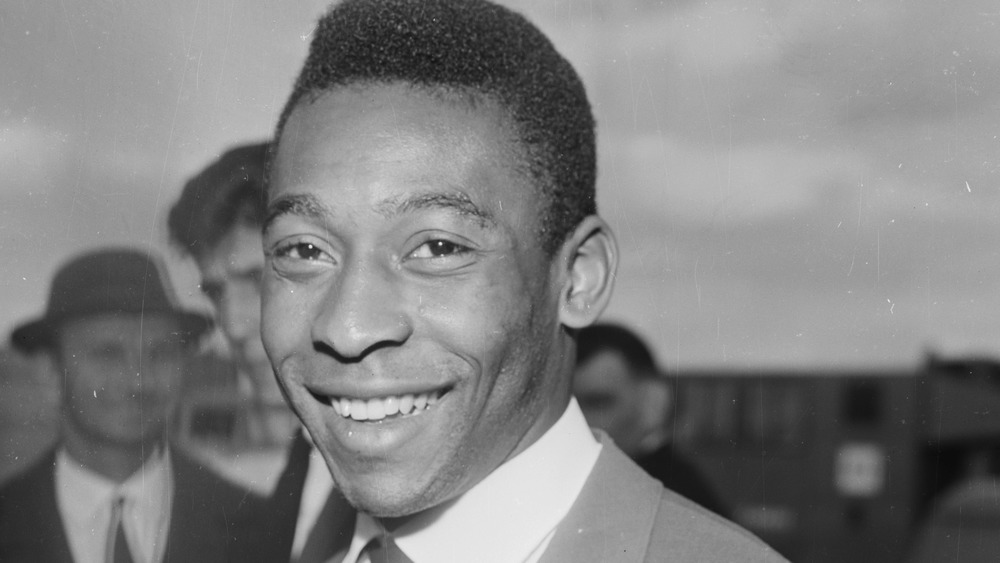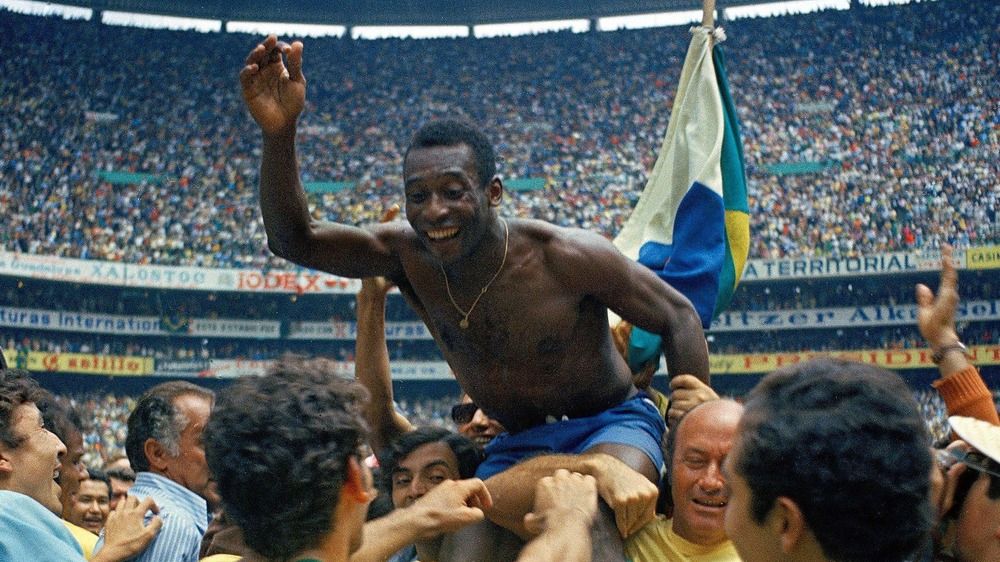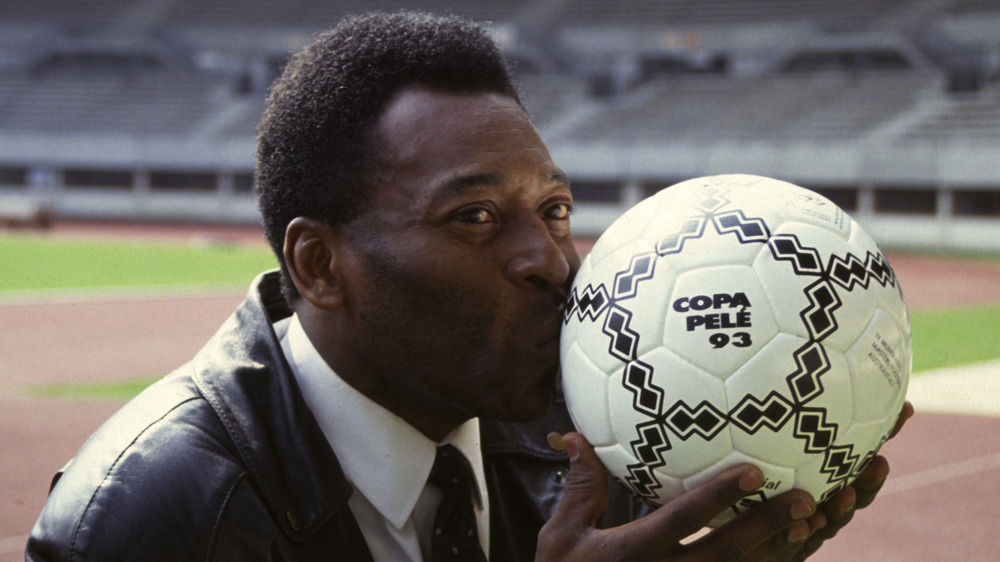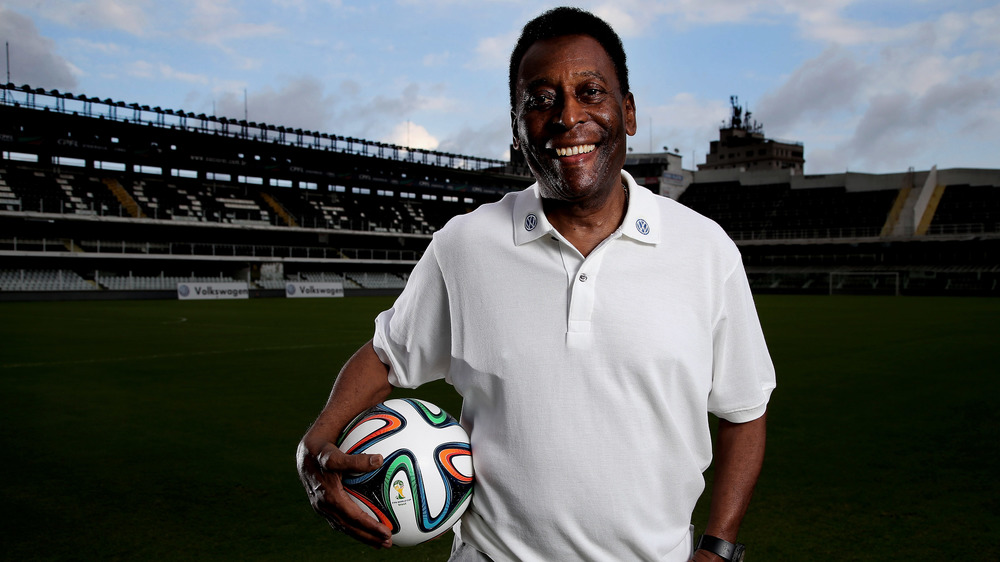What You Don't Know About Pele
There was a time in soccer when no name was bigger than Pelé. The Brazilian legend was a singular force known 'round the world during his nearly 20 years on the field, taking home three World Cup wins for the Brazilian national team. Pelé, who turned 80 in 2020, is still regarded "as the best soccer player of all time" by many, according to Biography.com.
But the ascension of Pelé, born as Edson Arantes do Nascimento in 1940, wasn't an easy one. He was raised in poverty during a time of political turbulence in Brazil and the surrounding region. Combine that background with some untimely injuries and unfavorable news headlines, and things haven't been all smooth sailing for the soccer forward.
Expect to see all that covered and more in the Netflix documentary, Pelé, out on Feb. 23, 2021. The movie "captures Pelé's extraordinary path from breakthrough talent to national hero." Keep reading for everything you didn't know about the larger-than-life soccer legend.
As a child, Pelé played soccer with a sock stuffed with rags
In the hinterlands of Brazil, young Edson Arantes do Nascimento didn't know why the other kids called him Pelé — and he wasn't sure that he liked it. To this day, nobody knows exactly what the moniker means, but his friends was bestowed it upon the young Brazilian for his early soccer prowess, and he eventually took it as his own, per ESPN.
While his father struggled to make a living playing soccer, Pelé was undaunted, even in the face of poverty. When he couldn't afford a soccer ball, the youth improvised by stuffing a sock full of rags, rolling it up, and kicking it around, per Biography.com.
Eventually, while playing on a youth squad, coach and former Brazilian national soccer team member, Waldemar de Brito, recognized Pelé's inherent talent. Brito persuaded the boy's parents to allow Pelé (pictured above in 1963) to try out for a professional soccer club.
He made his international debut at age 17 and helped Brazil win the World Cup
Within two years of becoming a professional soccer player, Pelé had made his way to the 1958 World Cup in Sweden, the first to be broadcast internationally, per ESPN. "Black and white screens flickered as a skinny 17-year-old, playing with imagination and verve, ran circles around seasoned veterans," the site noted. "By the end of that World Cup, the name Pelé had shot across the globe."
After helping Brazil take the cup, beating Sweden at home, Pelé was declared a national treasure by the Brazilian president — which was a double-edged sword, according to Biography.com. Yes, it was an honor, but it also hindered Pelé's opportunities of playing for any of the European soccer clubs that were courting him with lucrative deals.
So, he remained in Brazil and took home the World Cup twice more, in 1962 and 1970 (pictured above after the 1970 win). In his heyday, Pelé was the highest-paid team athlete in the world. "If you would use the word perfect, Pelé almost is there," said former West German star Franz Beckenbauer on ESPN Classic's SportsCentury, per ESPN. "He was the greatest soccer player in the history of this game."
Pelé soon became one of the biggest stars in the world
Of course, after attaining such fame, Pelé became a massive target of opponents on the soccer field. In the 1966 World Cup, he and his team were defeated within one round after "a series of brutal attacks by opposing defenders again forced him to the sidelines with leg injuries," per Biography.com.
But nothing could diminish his star power. During the Nigerian Civil War, the two opposing sides called a temporary ceasefire so they could watch Pelé play an exhibition game in Lagos, per ESPN. Once, the Shah of Iran waited at an airport for three hours just to talk to the man, and "a survey in the early 1970s showed that the name Pelé ranked behind only Coca-Cola as the most popular brand in Europe."
Although Pelé (pictured above in 1993) announced his retirement in 1974, he played for the New York Cosmos in the North American Soccer League for a couple of years, per Biography.com.
Post-retirement, Pelé has made headlines for philanthropy and his love life
Since retiring, Pelé has since devoted much of his time to philanthropy, according to Biography.com, which notes that the soccer pro "was awarded the International Peace Award for his work with UNICEF. He has also served as Brazil's Extraordinary Minister for Sport and a United Nations ambassador for ecology and the environment."
"Heroes walk alone, but they become myths when they ennoble the lives and touch the hearts of all of us," said former Secretary of State Henry Kissinger, per ESPN. "For those who love soccer, Edson Arantes do Nascimento, generally known as Pelé, is a hero."
For better or for worse, Pelé (pictured above in 2014) has also been known for his headline-making personal life, having been married three times and divorced twice, per Sportscasting. He had several extramarital affairs as well as children out of wedlock, some of whom he has refused to recognize, according to the site. He's been married to businesswoman Marcia Cibele Aoki since 2016.
The Netflix documentary promises 'unprecedented interview access to Pelé'
Viewers of the Netflix documentary may be privy to new details about Pelé's storied life, since it features "unprecedented interview access to Pelé," according to a press release from Netflix, as per Yahoo! News — as well as "astounding archive footage and interviews with legendary former team-mates including Zagallo, Jairzinho, and Rivellino."
The movie — which was directed by David Tryhorn and Ben Nicholas and executive-produced by Kevin Macdonald — offers a unique look at the "extraordinary 12-year period in which Pelé, the only man to win three World Cup titles, went from young superstar ... to national hero," according to Netflix.
Macdonald won the Academy Award for Best Documentary Feature for directing One Day in September in 1999, and he also directed the critically acclaimed 2006 film The Last King of Scotland. Translation: This should be a first-rate biographical documentary that paints Pelé not as an untouchable national treasure but as the three-dimensional man he truly is — including the good, the bad, and the ugly.






